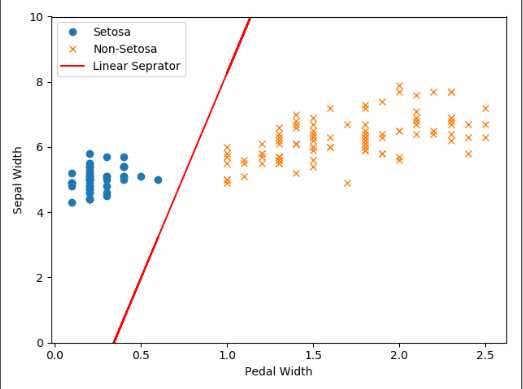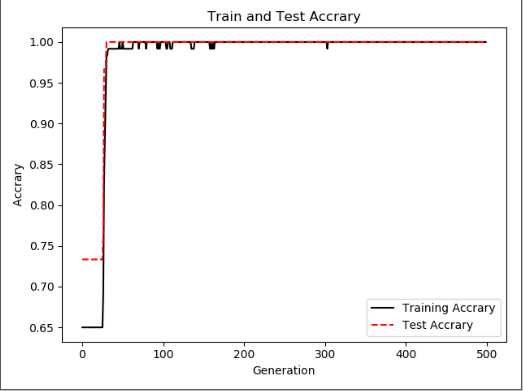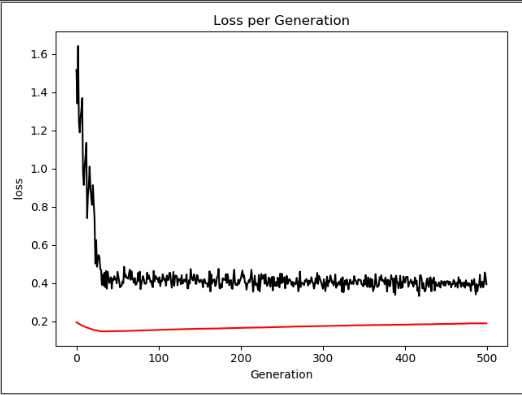TensorFlow 线性支持向量机的使用
Posted x0216u
tags:
篇首语:本文由小常识网(cha138.com)小编为大家整理,主要介绍了TensorFlow 线性支持向量机的使用相关的知识,希望对你有一定的参考价值。
#在TensorFlow实现一个soft margin 支持向量机 #损失函数 惩罚项 使用L2范数 # 1/n*Σmax(0, y(Ax-b)) +Σ||A||^2 import tensorflow as tf import numpy as np import matplotlib.pyplot as plt from sklearn import datasets sess=tf.Session() #加载鸢尾花集合 iris=datasets.load_iris() #提取特征 x_vals=np.array([ [x[0],x[3] ]for x in iris.data]) #山鸢尾花为1 否则为-1 y_vals=np.array([ 1 if y==0 else -1 for y in iris.target]) #分割训练集 测试集 train_indices=np.random.choice(len(x_vals),round(len(x_vals)*0.8),replace=False) test_indices=list(set(range(len(x_vals)))-set(train_indices)) #数组分片操作 使得 x_vals必须要array类型 x_vals_train=x_vals[train_indices] y_vals_trian=y_vals[train_indices] x_vals_test=x_vals[test_indices] y_vals_test=y_vals[test_indices] #设置批量大小 希望用非常大的批量 因为小的批量会使 最大间隔线缓慢移动 batch_size=80 #设置变量 占位符 x_data=tf.placeholder(shape=[None,2],dtype=tf.float32) y_target=tf.placeholder(shape=[None,1],dtype=tf.float32) A=tf.Variable(tf.random_normal(shape=[2,1])) b=tf.Variable(tf.random_normal(shape=[1,1])) #输出 y=Ax-b model_out=tf.subtract(tf.matmul(x_data,A),b) #声明最大间隔损失函数。首先声明一个函数计算L2范数,接着增加间隔参数alpha l2_norm=tf.reduce_sum(tf.square(A)) alpha=tf.constant([0.1]) l2=tf.multiply(alpha,l2_norm) #分类器 该处y为真实值 1/n*Σmax(0, y(Ax-b)) +Σ||A||^2 classification_term=tf.reduce_mean(tf.maximum(0.,tf.subtract(1.,tf.multiply(y_target,model_out)))) loss=tf.add(classification_term,l2) #增加预测函数 和 准确度函数 prediction=tf.sign(model_out) #tf.sign ==-1,0,1 accuracy=tf.reduce_mean(tf.cast(tf.equal(prediction,y_target) ,tf.float32)) #梯度下降 my_opt=tf.train.GradientDescentOptimizer(0.01) train_step=my_opt.minimize(loss) #初始化上述变量 init=tf.global_variables_initializer() sess.run(init) #开始遍历迭代 loss_rec=[] train_acc_rec=[] test_acc_rec=[] l2_rec=[] for i in range(500): rand_index=np.random.choice(len(x_vals_train),size=batch_size) #shape(None,2) rand_x= x_vals_train[rand_index] rand_y= np.transpose([y_vals_trian[rand_index]]) #运行 sess.run(train_step,feed_dict={x_data:rand_x,y_target:rand_y}) temp_loss =sess.run(loss,feed_dict={x_data:rand_x,y_target:rand_y}) #添加记录 loss_rec.append(temp_loss) #带入所有训练集 查看精确度 train_acc_temp=sess.run(accuracy,feed_dict={x_data:x_vals_train,y_target:np.transpose([y_vals_trian])}) train_acc_rec.append(train_acc_temp) # 带入所有测试集 查看精确度 test_acc_temp=sess.run(accuracy,feed_dict={x_data:x_vals_test,y_target:np.transpose([y_vals_test])}) test_acc_rec.append(test_acc_temp) l2_rec.append(sess.run(l2)) #打印 if (i+1)%100==0: print(‘Step:%d A=%s ‘%(i,str(sess.run(A)))) print(‘b=%s‘%str(sess.run(b))) print(‘Loss:%s‘% str(temp_loss)) #抽取系数 画图 [[a1],[a2]]=sess.run(A) [[b]]=sess.run(b) #a1x1+a2*x2-b=0 ==> x1=-a2*x2/a1 + b/a1 slope=-a2/a1 y_intercept=b/a1 x1_vals=[ x[1] for x in x_vals] #最优分割线 对应所有数据 best_fit=[] for i in x1_vals: best_fit.append(slope*i+y_intercept) #展示全部数据 setosa_x=[ s[1] for i,s in enumerate(x_vals) if y_vals[i] == 1] setosa_y=[ s[0] for i,s in enumerate(x_vals) if y_vals[i] == 1] not_setpsa_x=[ s[1] for i,s in enumerate(x_vals) if y_vals[i] == -1] not_setpsa_y=[ s[0] for i,s in enumerate(x_vals) if y_vals[i] == -1] plt.plot(setosa_x,setosa_y,‘o‘,label=‘Setosa‘) plt.plot(not_setpsa_x,not_setpsa_y,‘x‘,label=‘Non-Setosa‘) plt.plot(x1_vals,best_fit,‘r-‘,label=‘Linear Seprator‘) plt.xlabel(‘Pedal Width‘) plt.ylabel(‘Sepal Width‘) plt.ylim([0,10]) plt.legend(loc=‘upper left‘) plt.show() plt.plot(train_acc_rec,‘k-‘,label=‘Training Accrary‘) plt.plot(test_acc_rec,‘r--‘,label=‘Test Accrary‘) plt.title(‘Train and Test Accrary‘) plt.xlabel(‘Generation‘) plt.ylabel(‘ Accrary ‘) plt.legend(loc=‘lower right‘) plt.show() plt.plot(loss_rec,‘k-‘,label=‘Loss‘) plt.title(‘Loss per Generation‘) plt.xlabel(‘Generation‘) plt.ylabel(‘ loss ‘) plt.plot(l2_rec,‘r-‘,label=‘L2‘) plt.show()



以上是关于TensorFlow 线性支持向量机的使用的主要内容,如果未能解决你的问题,请参考以下文章